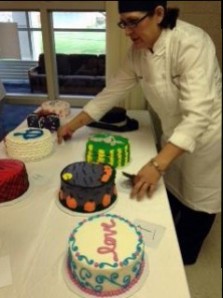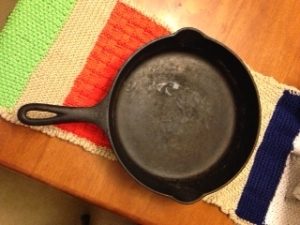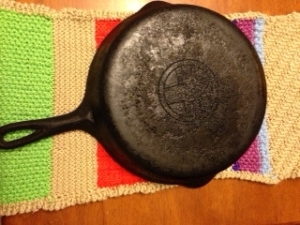…a cast iron skillet.
Let T-Fal and Teflon
Take flight!
I was using a kind of flat, shovel-shaped, wooden spoon-type thing to chop ground beef in my cast iron skillet, kind of mushing it down to brown evenly, when I had one of those clear, bright, sensory memories. Suddenly I saw my little mother, five feet four inches and maybe 120 pounds, as they used to say, soaking wet, hair a kind of wild auburn, brown, and gray halo around her intense, concentrating face,–saw her chopping a big chunk of frozen burger with a butcher knife. It was way before the day of the microwave; if you forgot to take the meat out to defrost, your options were limited.
Mom liked to decimate it into smaller pieces, which then cooked down faster. She’d turn the fire on low under the cast iron skillet, trowel in a little bacon fat, and–WHACK!–chop off a solid chunk of frozen hamburger and throw it into the hot pan, where it would sizzle and spit in the grease.
She was a little wild-eyed on days like that, a little scary. I’d slink away from the kitchen, slide into the living room to watch TV. But the big pot of thick hamburger gravy, served over mashed potatoes, with a hefty side helping of canned peas, was delicious and hearty—not harmed a bit by all that whacking.
The skillet she used could very well be the same one I was using to brown burger for Johnny Marzetti. When Mark and I got married, my parents gave us one of their skillets, and his parents gave us another. That was almost 35 years ago. I’ve cooked my way through a series of omelet pans, Teflon fryers, and T-Fal skillets in those years, used ’em and cast ’em away. My cast iron skillets are still going strong.
I started wondering about how old they might be, and where they came from, so we deciphered the block print in a big cross on the back of one of the pans. It said “Griswold,” and I looked that up on-line, discovered the pans were made in Erie, Pennsylvania, not so very far from where I grew up. The Griswold Company had been in operation since 1865, the last year of the Civil War; they folded, crippled, according to Wikipedia, by labor and economic problems, in 1957.
Judging by their markings–and by family history–our pans came out of the plant between 1919 and 1940, before our fathers marched off to to do their patriotic duty, before those idealistic young men saw and experienced things that would change their lives and outlooks forever. Mark’s dad, Angelo, served in the Navy, shipboard on the O’Bannon; he remembers the ship’s cook taking special care of him when he developed a devastating stomach ulcer.
My dad was in the Army; he did not have fond memories of the food. He couldn’t wait to get home to eat home cooking–he vowed to never eat another bite of Spam in this lifetime. And, of course, with war-time rationing and meat coupons scarce, the first meal my mother offered was Spam, fried crisp in that cast iron skillet. That was the last time Spam touched that skillet; not once, in my whole memory, did that meat-like substance ever enter our house.
But the skillet cooked a whole heck of a lot of bacon. My mother had a thick white ceramic mug into which she poured off the fat. And then she’d wrap two dish towels around the hot, hot handle, and, rearing around, stick the skillet into the deep farm-style sink, full of sudsy water; we loved to watch the steam explode and hear the angry hissing.
Our kitchen could be a risky, exciting place to spectate.
Mom saved the bacon fat and used it, again in the skillet, to fry up any number of things–fried bologna, which my father favored; eggs, cooked so the yolks were almost hard. Fried egg sandwiches were one of my parents’ favorite meatless Friday meals. I’m not sure those eggs in bacon fat met the letter of pre-Vatican Catholic law, but my mother never wavered. She even experimented with making hard little funny homemade doughnuts; she fried them in a couple of inches of melted, snapping bacon fat. She would shake them in powdered sugar, crisp and thick with bacon grease. We would munch them down.
On very, very special occasions, my father would wrap a towel around his waist, fill the cast iron skillet with solid shortening and start it to melting down. He would put us–any of us he could catch and corral–to work peeling potatoes. It was, we imagined, like being on KP in the Army–we peeled what felt like piles of potatoes, and he’d look critically and say, “More.” Then we had to slice them, and the slices had to be thin enough to please; we’d put the sliced spuds in a cold water bath in a big old metal bowl, and, when he judged the fat was hot enough, Dad would start throwing the potatoes in, humming, cigarette dangling dangerously close to the food, stirring and flipping those homemade potato chips.
He lined a big bowl with layers of paper towels, and he’d flip the finished chips in and liberally salt them.
Oh, we loved those things, loved to grab them, as they hissed and sizzled on their greasy bed of paper towels, juggling them with our burned fingers and eating them straight from the bowl.
“They taste just like McDonald’s!” someone would say.
We had been to McDonald’s once, when my brothers’ Little League team (which my father coached) went to the regional tournament in Jamestown, New York, 35 miles away from our small town. We had eaten our first fast food burgers and fries; we had all had chocolate milkshakes; and we had heard the angels sing. I can’t remember if the team won or lost, but I can remember how those fries tasted.
Dad’s homemade chips were as good, if not better. They were such a complex operation that, on those rare occasions he’d cooked them–maybe every two years or so–they constituted the entire meal. And we were happy, more than happy, with that.
Mark remembers Angelo searing meatballs in the cast iron skillet, getting a nice crust on them before putting them to simmer in an all-day pot of red sauce. His dad cooked cardone in the skillet, too—crisp little fritters of egg and flour and wild burdock with herbs and spices. Those met with mixed reviews, but Angelo loved to make them and loved to eat them.
Those skillets served up lots of meals to two big, hungry families. When they came to us, they learned a couple of new tricks–we like to put cornbread batter in a greased and sizzling skillet to bake; we saute breaded eggplant and then bake it, layered with cheese and sauce until it’s bubbling and oozing. We rub the skillets down with grease occasionally–we use vegetable oil, the custom of saving bacon fat having been lost, in our household–coat them well, rub the excess off, and bake them for an hour at 325 every so often to keep them seasoned.
So Griswold skillets have been on my mind. And yesterday, Roberta, a gifted chef and adjunct faculty member, invited me into the culinary lab to see the cakes her students had created for their practicum. All the cakes were two layer round creations, all baked in the same regulation-sized pans. But, within those similarities, the students’ imaginations had taken flight, and there were flowery ‘love’ cakes, ‘Frozen’ cakes, and a fall cake with a sturdy chocolate tree, frosting leaves falling, and whimsical little owls made of marzipan. There were air-brushed cakes and there was sculpted chocolate on cakes, and there was fondant in many colors and guises. There was a cake that looked like a Stetson hat; its brim rolled off the plate and slanted up toward the hat itself, cockily, on one side.
“You go ahead and pick your favorite,” Roberta said. I looked at all those cakes, and I looked at all the students, flushed with pride and accomplishment, and I said, “No.” They were all amazing, those cakes.
We talked a bit; I got to hear how the students had been inspired. I was inspired by their excitement and their passion for their craft. But then I had to go back to my office and get some work done.
So I cut through the kitchen, and I noticed a cast iron contraption sitting on the vast gleaming metal counter top.
“What is this?” I asked Roberta.
She opened it; inside there was a cast-iron waffle maker. She flipped it over. The bottom had that tell-tale cross. It proudly admitted to being a Griswold product, made in 1908.
“Wow,” I said. Roberta nodded.
“These babies,” she said, “were made to last.”
So I think of our two pans, and I think of our two sons, and I picture them in some long distant–I hope–day, a day when Mark and I are well-loved memories. In my mind’s eye, they have thick dish towels wrapped around the handles of their skillets, and they are running–running those skillets to some big old sink after using them to cook up a big batch of–what? Jambalaya? Chicken wings? Browned and beautiful French toast?
Maybe I’ll be watching them from a cloud, sitting with Mark, and my parents and his, and we’ll all be smiling. It’ll be like we’re watching a relay race we all ran a heat in; our laps over, we can rest and watch the young ones carry on. Which I hope they’ll do for a long, long time, but way out there in the distance, I see granddaughters limbering up, reaching hands back.
“Slap that skillet HERE, Bubba!” they’re yelling, bouncing, ready to rush off into their own exciting lives.
Things are just things, after all, but these things, these Griswold skillets, carry a whole lot of memories in their sturdy black selves. I hope they’ll still be in the race a hundred years from now.




How well I remember the cast iron pan. I used one a good part of my life. I treated special. The Teflon pans are not as good
I have been through a LOT of Teflon pans!!!!
I love this! My husband is making cornbread in a cast iron pan, at this very minute. As a matter of fact, we have an entire collection of cast iron pans, and pots, included dutch ovens. He uses them for most everything: any occasion that requires a non-stick surface, things that go in the oven, or for braising since they distribute heat so evenly and admittedly, he admittedly also uses them simply because the presentation looks so much better in cast iron, like “almost everything, he says, but “particularly anything that looks hearty, like beans, duck, anything that you would eat in a cabin”. What he wouldn’t make in cast iron are things that are really sticky, like flour based gravy or cheese-based sauces since you don’t want to scrub the seasoning of the pan.
That is so cool! I am thinking of cast iron for the next generation for Christmas…we have an Amish hardware not too, too far away with an amazing assortment. How did you build your collection?
You will have to teach the next gen how to use them. We still get housekeepers that insist on washing them after each use. My husband inherited his collection; some of them dating back centuries. He did say that outdoor stores carry them.
Also, my husband said that you might want to check antique stores because apparently around the ’50s manufacturers switched from solid casting to sand casting, which doesnt work quite as well.
That is a great tip! Thank h for me!
LOVE this post! I love and treasure my old Griswold pan, too–it works beautifully for everything, and cleans up easily. It was my mom’s, and now that she and Dad are practically vegetarians, she only needs one pan and gifted me with the other Griswold. I too fondly remember meals out of it, and know that it’s one of the few things we have that really DOES last!
How nice to connect to another Griswold user!!! It IS lovely to have something that truly withstands all the battering time gives out…
What a wonderful post – I think that one of the traits of a good writer is being able to weave a story about the simple and mundane things in life. This story is certainly wonderfully woven around the skillet. Feels so wonderfully home-cooked as well! I saw a skillet for the first time early this year in a second-hand store. In the Philippines we are more familiar with Teflon pans. My mother wouldn’t let go of the set of two, so we bought it. It was the heaviest pans I’ve seen and she said, “That’s what they use to hit people’s head with.” I always wondered why American movies show people hitting thieves on the head with pans and the robber would pass out. Now I understand! I had to run to the kitchen after reading your post just in case the pans are Groswolds. Nope, they’re stamped Ruff Hewn. Although the pans we bought looked new, they’re not non-stick as we anticipated. Or maybe there’s a trick to using it.
I enjoy reading your posts. Someday I hope I will be able to weave stories about life the way you do.
Thank you, Rosanna; I think you weave words quite well! I find the cast iron definitely needs oil or grease… They are not non-stick…the one negative I find….
I see. I thought the ones we bought were not the real thing. Thanks !
Oh, I’m sure they are the real thing!
I love my cast iron. I have a beautiful collection and use every piece. Skillets, casseroles, bread pans, Dutch ovens, sauce pans. It adds iron to everything I cook, relieving anemia. Properly treated, it’s non- stick. I cook over the open fire in the type with legs. It’s the most wonderful cookware in the world.
Bread pans! I have never thought of that! I am going to look for one!
I love your story. It really takes me back to the way my mom cooked, only she was 5′ 10″ and about 300 pounds. She’d cook everything at the highest heat possible then my dad would come in and turn it down. It was a funny kind of play they’d put on. She’d burn something, shove the pan to the back of the stove and get frustrated, only she never would turn it down.
There’s one cast iron pan she had that I wish I had now. I’m hunting down thrift and yard sales for one. A big wide and deep skillet that can handle a couple pounds of meet for special occasions. I have one that I can use for sausage gravy but it’s tippy top and always spills a little.
We had lots of spam and fried baloney, and the bacon grease was always saved. Whatever that meal is with ground beef and brown gravy over potatoes, I ate a lot of that. She got us through the leanest times with six of us.
It is amazing how they made things work! We were never allowed to have Spam because my father vowed he’d never eat another bite after WWII! I love the fact that a homely thing like a frying pan can hold so much significance. I have a clear picture of your parents from your reply…
My childhood was difficult but I’m trying to move past to the few good memories of mom and making things better for my kids.
I understand about Spam. My mom said the same thing about Kraft dinner. Never again!
I understand that completely. I have to think the good times gave us hope and the bad times made us stronger!
Definitely~